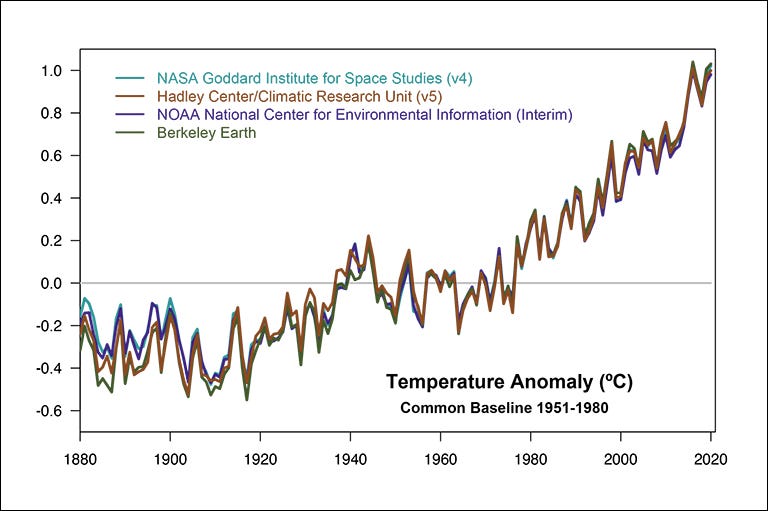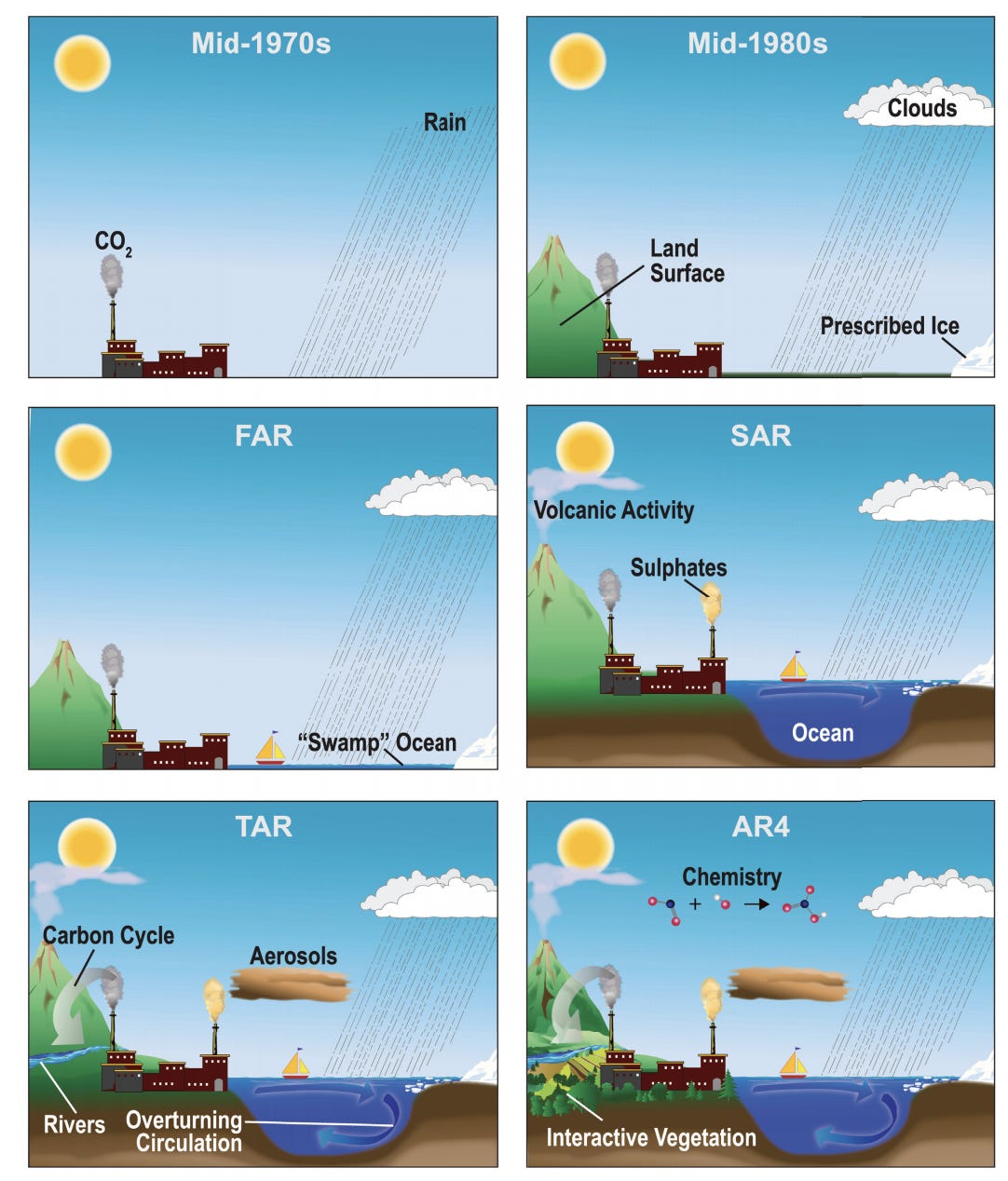Special edition on the science
(6 min) Can we predict the future?
Concerned about climate change but don’t know where to start? Follow along!
Why the scientific process matters
Last time, we touched on how a changing climate has likely already started impacting humans on Earth- mostly by making extreme weather (heat waves, storms, floods) more intense. Before jumping into scientific predictions on warming, it’s worth deep-diving on how these predictions are made.
This sterile information is what we should base our judgements on; anything beyond that is extrapolation & operating on faith. If we truly care about making a difference by creating a more sustainable world for humans everywhere, it’s vital to bridge the gap between conjecture & fact.
Our best friend named Science
We don’t give science enough credit. Without it, we’d all still be smashing proverbial rocks together hoping for a spark. It’s critical to grasp why we rely on science since every downstream decision (political, economic, technological etc) stems from this understanding.
The scientific method is the best way humans have found, so far, to translate theories into knowledge. It works by developing a hypothesis (theory) of how the world works based on assumptions, designing a controlled experiment to observe if the theory is correct (collect facts), then drawing generalizable conclusions (knowledge) to predict the future (models).
If done correctly, the scientific method produces explainable, reproducible predictions for the future... at least until those models start to break down with new theories.
For instance, scientists were quite confident that Newton’s laws of motion were elemental truths of the universe… until Einstein discovered that they weren’t always true by testing an underlying assumption on Newton’s theories. Namely, that space and time are constant. That doesn’t mean that Newton’s models are no longer valid, rather they are incomplete. Now, Einstein’s laws are being put to the test as well.
Science Scorecard
When applied to climate change, we have a theory that CO2 is the leading cause of our warming biosphere (hypothesis), we have deployed countless instruments to detect changes (facts), and are drawing conclusions that the best way to limit warming is to limit emissions (knowledge) to avoid a climate catastrophe (models).
In order for a scientific theory to work, it needs to be explainable (why did x do y), reproducible (if I change x again, will y happen again), and falsifiable (can an experiment be run to show x doesn’t do y).
Hypothesis: CO2 is the leading source of warming
We’d previously covered the leading points for this hypothesis:
It’s unlikely that solar changes explain the temperature anomaly
It’s unlikely that other terrestrial changes explain the temperature anomaly
It’s likely that CO2 (and other greenhouse gases) play a leading role
Simple, right? Not quite…
The first hallmark of a good scientific theory is explainability. We need a theory to explain why the warming is attributable to the role of greenhouse gases. In order to explain this portion of Climatology, we must also be able to explain the subdomains of Atmospheric, Oceanic, and Geologic science (among others). In order to explain the subsystems, we must be able to explain the fundamental physics and chemistry that power them, and so on and so on…

Put differently, we need to be able to explain why changing CO2 concentration will change temperatures via the complex interactions of all of these subdomains. Turns out, that’s really fucking hard, but not impossible. We’ve been layering in new components over time to explain more and more, but we’re still not quite there. We’ll get into this more later.

Facts: how do we test our theories?
Once we have our theory, we need data. Testing the theory of GHGs requires collecting a long history of inputs (GHG concentrations) and outputs (temperature measurements).
In order for a theory to be tested, you must be able to run an experiment. Unfortunately, it’s impossible to run controlled experiments for climatology because, well, we’d need to change the entire world. Instead, climatologists collect a long history of past measurements for inputs (GHG concentrations) and outputs (temperature) and compare that to the theory.
For the last 200 years, we’ve had fairly consistent & reliable temperature measurements from stations around the world. While there are different ways to interpret errors from some older measurements (e.g. bias from reading inside a boat vs outside a boat), the estimates more or less match up.

Since thermometers & spectrometers are relatively new, we need to use other techniques to collect data as a proxy (like ice cores & tree rings). All of this data is normalized to get an accurate global record of temperature & CO2 dating back thousands of years that we believe is reliable.

Knowledge: Building a climate model
Once we have data on how the world has changed, we need to see how it stacks up with our hypothesis. If the hypothesis doesn’t really explain it, we need to add new elements and iterate until the model explains the historical record.
As you can imagine, climate science is really fucking hard because there are so many different things to explain. In order to answer the big questions (how will Earth’s climate change?) and bigger questions (what does this mean for humans?), scientists must also be able to answer all of the smaller questions (how and where do clouds form?).
Scientists have been trying to painstakingly design, test, and validate hypotheses along this logical chain by developing increasingly complex models.

The reality is that we cannot yet fully explain why rising GHGs lead to a specific amount of warming since there are many feedback mechanisms with wide error bars, but scientists believe we have a good enough understanding to assign causation.

Put differently, we cannot describe the observed changes in temperature without including the warming effect of GHGs. The end result is that “it’s very likely that more than half of observed temperature change is from anthropogenic greenhouse gas emissions” (pg 869, very likely = > 90%).
Models: What happens next?
This is where the rubber hits the road: if we know that GHGs have had some impact on warming and we continue to emit more GHGs, what will happen next to our environment?
As an old professor once told me, “All models are wrong, but some models are useful”. Climate models will never precisely predict how the Earth’s climate will change and we shouldn’t expect them to. It would be naive to say we have it ‘all figured out’ as history has proven that models will change. New information that challenges assumptions or new feedbacks that have yet to be discovered could radically change our outlook. But, that doesn’t mean they should be ignored.
I’m not going to pretend that I’m equipped to evaluate the statistics, experiment design, data collection etc associated with building a climate model. Rather, I can point to the documented uncertainty to project a range. Check out part 2 for a deep dive.
Enjoy this article? Consider subscribing!
Thanks for coming to my Tedtalk,
Want more?
Dig into the core science of climate change here & the IPCC assessments on models, climate forcing, and attribution.
Chomping at the bit for more climate change content? Here are some of my favorites:
The Carbon Curve: Learning about the frontiers of carbon dioxide removal and carbon tech - and how to scale it up
Going Green: What problems need to be solved on the path to a carbon-free economy (digital and physical)?
🤷🏽♂️ Not My Problem: Startups across the world that are working towards improving the health of the planet
Evergreen: The main climate challenges and opportunities in front of us. Breaking down the particular causes of emissions within our economy and what solutions will get us to net zero.
Climate Money: How climate and money (finance, currencies, market opportunities) intersect
Climatic Thoughts: Solutions towards keeping the world under 2 degrees of warming
Climate Pioneers: Exploring low- and high-tech climate solutions.
Extra disclaimer: Science is never done and we’re always learning more. What’s presented here is the current global understanding from an ensemble of climate scientists across leading government organizations pulling from a range of peer-reviewed research (i.e. NASA, IPCC).
Usual disclaimers: I’m not an expert and will never claim to be. I’ll probably be lacking context, too vague, or flat-out wrong frequently & I hope folks will hold me accountable. After all, the fastest way to find the right answer is to post the wrong answer visibly on the Internet. Lastly, there is a ton of great information online already (e.g. Drawdown, Breakthrough Energy playbooks). I will synthesize and cite as I go.





